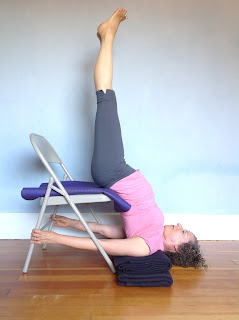In her interview with us (see Judith Lasater on Yoga and Aging), Judith Lasater mentioned the poses that she currently practices, citing "especially Viparita Karanai (Legs Up the Wall pose), Supported Sarvangasana (Shoulderstand) on the chair and Supported Halasana (Plow pose) on the Halasana bench." By chance—or maybe not by chance if you stop to think about it—those are some of my favorite poses, and I recently had a friend take some photos of me doing them so I could share them on the blog. Then, as it happened, someone left a comment on the interview with Judith, asking us to share two of the poses with you: the Shoulderstand in a Chair and Supported Halasana with a Halasana bench. That was the kick in the pants I needed. (We've covered Viparita Karani many times on the blog—see Featured Pose: Legs Up the Wall pose.)
Here is a photo of the Shoulderstand in a Chair. I'm doing the pose with my legs straight up because that's the way I prefer doing it. Some people, however, practice this pose in more of a backbend, with their legs supported on a bolster and their feet over the back of the chair. But I find that position less comfortable.
 |
| Shoulderstand in a Chair |
 |
| Supported Halasana |
So it they take so much practice to learn, why should you bother? Well, as many of you know by now, I'm a huge fan of inverted poses in general (see Just in Time for Holidays: Inverted Poses). Because you are upside down in these poses, they automatically trigger the relaxation response (see Why You Should Love Your Baroreceptors). And perhaps because these poses are slightly more physically active than restorative poses, the rest they provide feels more refreshing to me. So when I'm fatigued, a supported inversion practice is just the trick. These two poses provide the extra advantage of placing your legs higher than your heart (as well as your heart higher than your head). Having your legs higher than your heart means that gravity helps return the blood in your legs to your heart, improving your circulation and reducing swelling in your feet, ankles and legs. So these poses are wonderfully restorative for your legs when you've been on your feet all day, whether standing for your work, walking or running.
Chair Shoulderstand is one of the most soothing inverted poses because you are both supported and completely inverted. Although full Shoulderstand is considered a calming pose, the reality is that for most people—even relatively flexible people like me—the unsupported pose just is not that comfortable. Chair Shoulderstand, on the other hand, is very comfortable and you can hold the position for quite a while. I like to hold it for at least 6 minutes, because I can feel my "quiet switch" turn on after around 5 minutes. And you can do the Chair Shoulderstand in place of full Shoulderstand in any sequence.
Supported Halasana is a very quieting pose because you fold inward in addition to being inverted. Furthermore, as you hang from your hips in this pose, the traction on your back that this pose provides feels wonderful, particularly if your lower back is bothering you. That said, I really don't think this pose is for everyone. People who don't have flexible necks can find the extreme forward bending of the neck (flexion) in this pose uncomfortable. And some people with round bodies find it very difficult if not impossible to fold their bodies into this position. In this case, turning the pose upside down into a seated forward bend with head support is great alternative.
 |
| Supported Seated Forward Bend |
Tip: for women with large breasts, which tend to fall into your face in these poses, I recommend tying a strap around your upper chest before going into the pose.
No comments:
Post a Comment